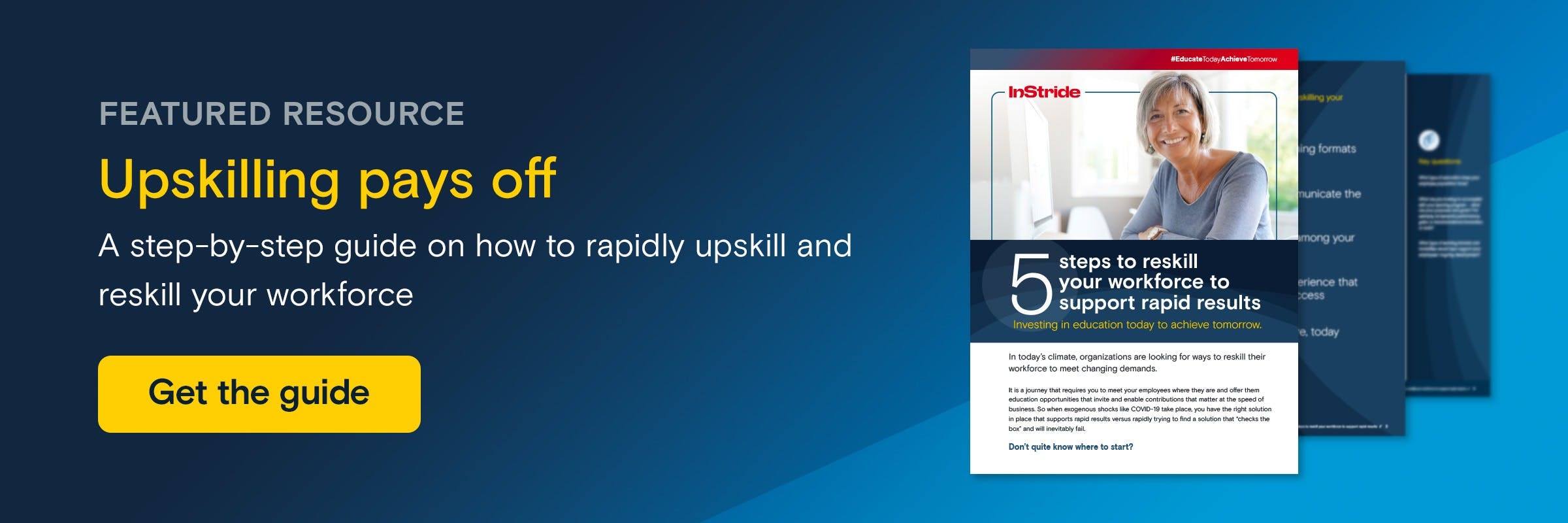

Stay informed with the biggest trends in workforce education.
I have read and acknowledge InStride’s Privacy PolicyMotivated, engaged and enthusiastic employees are critical to building and maintaining a successful business. Workers who feel good about what they do and know that they are valued drive performance, productivity and ultimately, have a positive influence on the health of the entire business.
Cultivating employee engagement should be a top priority for management in any industry. And one of the easiest and most effective ways to help your staff feel present and driven in their jobs is to encourage them to set development goals that always keep them moving forward.
But for employee goal setting to be effective, it has to be more than just something that managers check off their “to-do” list. Let’s dive into the basics of employee goal setting and how you can implement this high-impact practice within your organization.
Employee goal setting is the process of setting specific, measurable and role-oriented objectives that employees work towards while at your company. Typically, employee goals are a collaborative effort between a manager and a direct report. They take into account the employee’s personal growth targets, requirements of their future desired role and resource availability.
The idea is to use these work goals to measure performance throughout their time at your organization, evaluate development progress and suggest any upskilling or ongoing education which may be necessary to reach these goals. They can be short or long-term and any rewards for completing them should be scaled to their impact.
Leveraging goal setting to support talent development can lead to a myriad of benefits including:
While the benefits of employee goal setting are clear, there are also a number of challenges that can prevent you from realizing the benefits. The challenges of setting employee goals can include:

Setting employee goals is critical for team alignment, individual performance and ultimately, company growth. Here are some considerations to keep in mind when establishing goals for employees:
Depending on how you structure hierarchy and promotion within your organization, you may need or want to organize employee goals in a specific way to realistically manage expectations around advancement and responsibilities.
Here are a few types of employee goal setting structures that you can leverage:
Objectives and key results (OKRs) are used by individuals, teams or entire organizations to set actionable challenges and assign measurable outcomes. When a goal is determined, both the objective and key results are clearly defined to give the goal setter(s) a coherent path to follow.
The objective is a high-level goal that sets concrete expectations for a specific project. Key results are data points or activities along the way which track how a team or individual plans to achieve the objective.
A personal OKR might look something like this:
Objective: Build better relationships with co-workers on different teams.
Management by objectives (MBOs) is a goal setting strategy designed to improve both employee and company performance and boost engagement through a rewards-based system.
With this model, the manager and direct report work together to identify achievable employee targets which are in alignment with the greater goals of the organization. Achieving these goals is typically rewarded, either monetarily or through other forms of recognition such as an award or promotion. MBOs can also be used to set organizational or department-wide goals.

SMART stands for specific, measurable, achievable, relevant and time-bound. It’s common to also include efficacy and feedback (SMARTER) at the end of the acronym to illustrate the importance of evaluation in objective-setting. The SMART framework was designed to provide clear steps to assist individuals and organizations alike in achieving their goals.
Let’s look at an example of a SMART goal:
S — I want to gain the skills and experience necessary to become the HR Director at my company.
M — I will need to complete training courses X, Y and Z and hold the role of HR manager before I can advance to the director level.
A — I have the basic skills and experience necessary, as well as access to continuing education through my employer that will help me reach this goal.
R — I am succeeding in my current role as HR Specialist, and this career path fits within my larger life goals, and the goals of my company.
T — I will aim to fill the role of HR Manager and complete my master’s degree in the next 5 years. This will put me on track to becoming HR Director in 8 years.
There are a number of different “buckets” employees can utilize to set goals that range from the deeply personal to the organizational.
The common thread among work-related employee goal setting is the need for skills development. An employee goal may require a new degree, certificate or simply more comprehensive training to build on a specific skill set. To help employees set and reach their goals, organizations need to prioritize skill-building through strategic initiatives that make it possible, such as a workforce education program.
From improved engagement to better retention, it’s clear that there are many benefits to prioritizing employee goal setting within your organization. Plus, your team members will know that management cares about their growth and is committed to helping them advance their careers.
Now that you know the value of goal setting, the next step is to get started. Download this 6-step employee goal setting worksheet from InStride’s career education experts and start working towards goals with your team members today.


See how a partnership with InStride can meet the challenges of tomorrow, with action today.